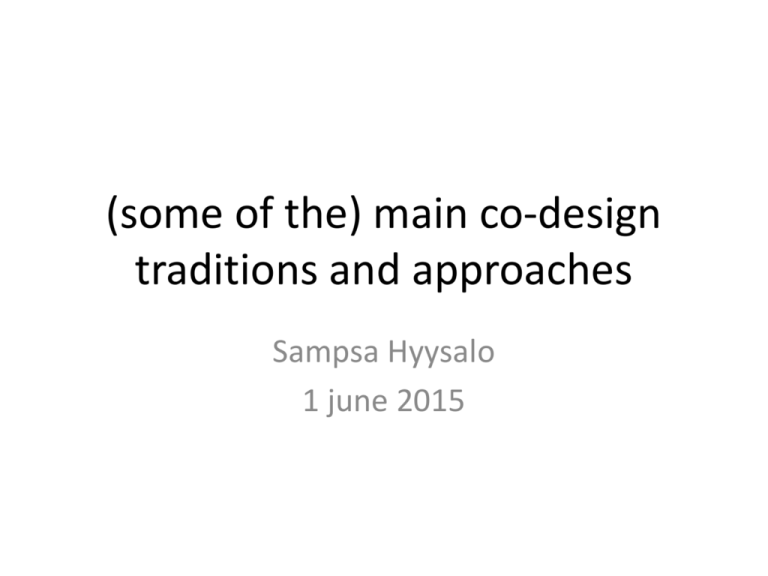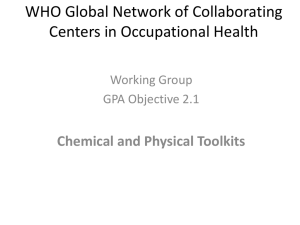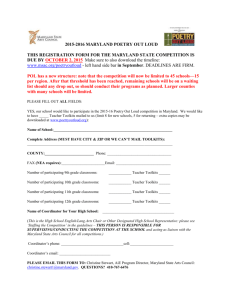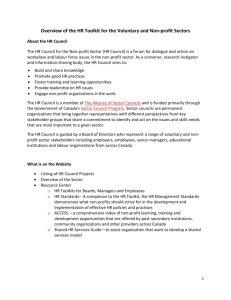Codesign approaches_sh_june2015_beginning
advertisement

(some of the) main co-design traditions and approaches Sampsa Hyysalo 1 june 2015 Sticky information U U U P P P U U Disciplines wherein co-design features; next to all features as a fringe activity • IT – – – • Business sciences – – – – • Sociology / organizational research (Action research, empowerment) Polictical science (participative democracy, empowerment etc.) Behavioral sciences – – • Industrial design (usability, User centred design, participatory design) Ergonomics, cognitive ergonomics Urban planning / architecture (participative processes, participatory design) Social sciences – – • Management (value co-creation, mass-customization) Innovation studies (user innovation research, UI toolkits) Marketing (relationships marketing, p2p campaigns) Financing (crowd funding) Design sciences – – – • Information systems (pd, work systems etc) Human computer interaction (usability etc) User centred design Psychology, cognitive science (Usability, user centred design) Education, Social psychology (action research, developmental work research) Service science, socio-technical systems, legal studies (agreements, ipr), philosophy (social and technological critique and clarification) Approach cut to co-design: Serious takes and differences Users hold primary agency and decision making power DESIGN in & with & for USE Primary focus: design process Participatory Design Emansipatory, empowering design; change of tech and subjects ”1980s PD” Conflict perspective, tradeunion power Producer-user co-development; often long term & ad hoc User research Sociotechnical design; Mutual benefits, work satisfaction Primary focus: Ergonomics, cognitive ergonomics Open Source development Everyday innovation; domestication, everyday hacking Usability research User inspired design User centred design product in/to use Customer research Innovation by users User innovation communities; peer content creation Firm / designers / researchers hold primary agency and decision making power User Innovations Market research Customer relationship manag. Masscustomization, user design toolkits Co-creation of value, partnering, user innovation toolkits ”1980s PD” Conflict perspective, tradeunion power UTOPIA Project, 1982 • With skilled typesetters: vaning profession / work replacement • Trade union power: not only vages but changes in the content of work and technology to be negotiated • “conflict perspective” starting point: conflicting interestes between management and workers (& worker groups) – Different workshops for different groups – Designing and visioning workshops • Mock-ups and paper prototypes: laser printers and large computer screens etc. User centred design Contextual Design AT&T 1993 for groupware, Karen Holzblatt ; Beyer & Holzblatt, 1998 1. “Contextual inquiry” = “watch and ask” in natural work settings or “artefact focused observational interview” “Interviewer interviews”, post-its and affinity diagramming to surface and manage data 2. Work modeling to clarify it further 3. Work redesign; consolidated work models and system models 4. System models and prototyping to iterate design 5. Realizing, iterating and evaluationg design and new work practice User innovation communities; peer content creation Patientslikeme.com • Rare disease patients • Doctors have little experience; perhaps treating 2 in a lifetime • Discussion forum • Medications, diets, symptoms etc. listed • Advice and pooling of treatment and experiences User Innovations User inventor Problem: Big hunting dog in suburbia; Snout leach needed, but dog walked backwards with just the snout pull & two leaches were difficult to manage Solution: embedding the snout leach inside (hollow) walking leach, can be activated when need be Development: 2006 Own functional prototype 2007 Trademark patent 2007 Licence agreement with Finnish dog brand “Nothing happening” : difficulties to turn the invention to dog brand’s materials and production facility in China non-working prototype 2011 Ending of licencing by inventor 2011 Future? Product design help ? // small manufacturing ? // user community proliferation ? // open licencing? ”I am not yet desperate enough to become a dog leach manufacturer, as I do have the researcher career to pursue” Co-creation of value, partnering, user innovation toolkits Coloplast Ltd. / Stoma-innovation by you.com • User innovation toolkits and internet communities for discussion and design • Colostomy patients; have to live with urine and /or feaces bags that determine much how they can attend physical and social situations • “Stoma innovation by you” discussion and design forum for sharing and iterating ideas • User innovation toolkits – Coloplast production materials sent as inspiratory toolkit – Designs by users • Some kept by the users alone • Some returned to coloplast as product seeds (easy to manufacture due to the materials from which they were made) • From personalizations (colors etc) to new designs to variations in how existing designs could work for specific needs of some patients • “Physical innovation toolkits” not only software http://www.coloplast.co m/Pages/home.aspx Masscustomization, mass design of one My Adidas • Small volumes almost at the price of mass-produced good • Computerized process equipment that can be adjusted instantly and at low cost • Mix and Match from predesigned lists of options… that is options that have been built into the machinery • “infinite variety” such as large color variations to several places in the shoe • People willing to pay for “reserving” their design, even as one parameter difference someplace gets to perceivably identical non-reserved design & two people hitting the exact same design is, in fact, improbable Nestle: User innovation toolkits user innovation toolkits • • Nestle’s (Mexican) sauce developmet (von hippel, 2001) Chefs create a sause in their kitchen; would like to get it ready made & Nestle a product – – – – • Innovation tookits: Repartioning development tasks – – – – – – • Nestle’s production chefs turn it into production compatible one Translation problem: Ingredients and machines must be of industrial scope: large processing units, storage, preservatives, additives… Only the final taste and some cues can be emulated…with different taste buds. Typically 26 weeks from chef design to production because of to and fro between chefs and production chefs to get it right Sent to Chefs working in their own kitchens: shifting factory chefs design capability to users. Factory production materials kit so that whatever is done fits Nestle’s production Module library: Finite set of materials; User friendly: 30 variations Iteration at the Kitchen (always local tuning needed!!) Improved translation: from chef to factory 3 weeks Nestle needed to understand what is the correct solution space (what 30 variations to offer for Chefs … and how to iterate this) Best in: – – – – – “high sticky info” domains (either dev or use) Rapidly changing markets where novelties are needed When optimal production is not THE issue (but better user fitting is) When majority follows lead-users or other trend setters When there is sufficient “maturity” someplace in the equation of use and dev so that users and developers know each other and what the other is doing From handicraft to co-configuration • Hamburgers and sandwitches – Handicraft: Restaurant Kosmos making a burger if you ask for one • Standardized aspects: Pikku Jaskan Grilli: beef and buns done in a set-time machine etc. ; only certain ingredients ordered to stock. – Mass production: McDonalds, Hesburger • Products, production, stocking, premises service, development activities all have fully designed manuals that are followed) … 40 mins to get rid of onions ! – Mass customization: Subway • Finite array of choices, choices realized almost as fast as in McD, stocking, service, premises just as mass production coded. – Co-configuration: ????? (in software e.g. browser memory and guessing) • Each customer can designate and vary the offer they are getting over time … almost as efficiently as in mass production







